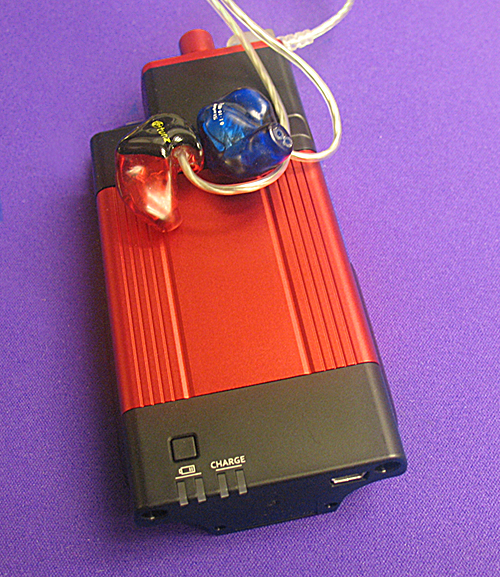
It’s a general rule that any audio product with combined features will never sound as good as products made for specific tasks. For instance, separate tuners and amplifiers sound better than stereo receivers, which contain both tuner and amp in one package. Which is all well and good as long as we are talking about an at-home setup. But that can become a bit of a pain when we go portable. What if you have an iPhone with your favorite tunes on it and you just can’t seem to get as much “oomph” from your headphones or earphones that you would like? If that’s the case, then a portable headphone amplifier will most likely cure that. But there’s a catch: That requires extra wiring for connecting to the iPhone and even more extra wiring to recharge itself as well as an extra thick rubber band to strap to your iPhone to keep all these pieces together. Now, this may sound much better compared to just the iPhone alone, but that kinda kills the whole idea of portability, doesn’t it? And try taking a phone call with all that extra load strapped on. Get the picture? Well, a Japanese company, VentureCraft, has decided to take a portable headphone amp and marry it to a rechargeable iPhone case, called Go-Dap.
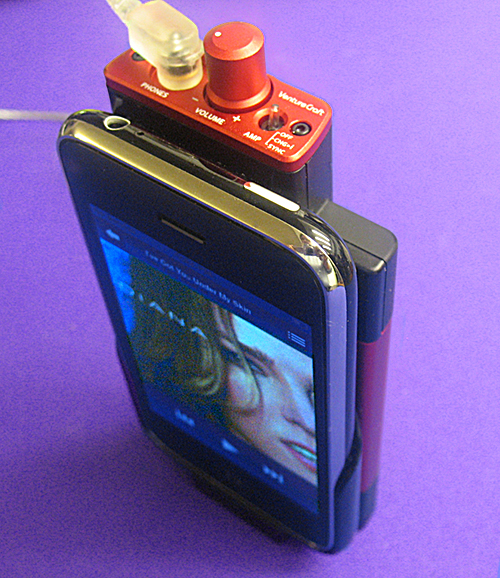
When reviewing a new pair of headphones, earphones or any piece of audio gear for that matter, I try to stay away from spec numbers. Whether it’s frequency response, distortion levels or whatever mathematical measurement it may be, I’ve discovered that generally, they don’t mean squat for two good reasons: Companies routinely twist those spec numbers to sound way better than they should and audio is a pretty subjective thing, meaning that you can have products that look great by the numbers but sound terrible. Add to that, what might sound good to me, you may not like. And while I love reading tech-based audiophile articles and reviews from different sources, I realize that I’m in a minority and so I try to gear my reviews to that reader who just wants to know how good – or bad – something sounds in language they can understand.
In the case of portable headphone amps, there are some incredible sounding and pricey choices out there that also have great spec numbers. VentureCraft’s Go-Dap have impressive specs, but so what? I want to know if my iPhone 3G/GS sounds better with it than it does without. Simple enough, heh?
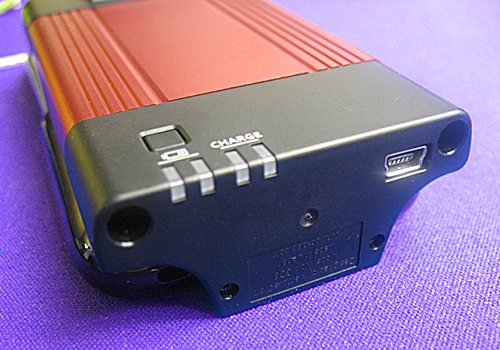
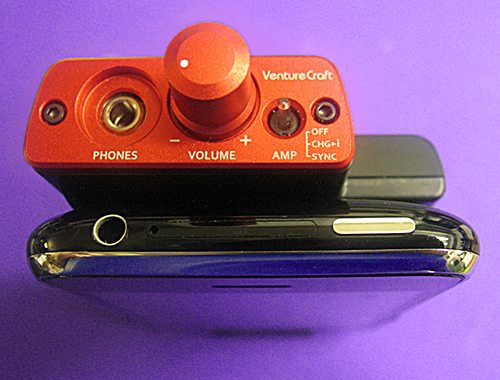
First, lets go over the few switches and buttons on the unit. On the back you only have one button and that just tells you how the battery charge is holding up. On top, it gets more complicated. There is a mini-jack for headphones/earphones. Although it’s recessed, the opening is wide enough that I could not find any phones in my collection that would not fit. Then you have a nice, solid volume knob. Note that when docked to the Go-Dap, your iPhone volume control will not work. There is a lighted toggle switch with three amp settings: Off, Charge and Sync. The Sync button can be confusing, but it basically means that in Sync, the amp is on but the Go-Dap battery is not charging the iPhone. Plus you can sync to iTunes in this mode. While the Go-Dap is happy to charge the iPhone’s battery, if it runs out of juice and your iPhone is still charged, too bad. The Go-Dap cannot use the iPhones battery for backup. Charging is a one-way street.
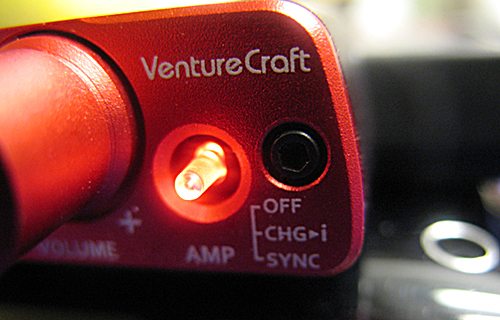
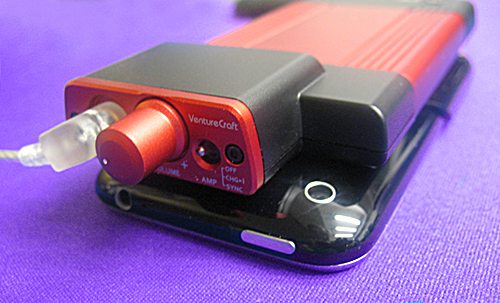
With the iPhone 3G/GS docked to the Go-Dap, everything works as it should. The fit is snug enough, but I wouldn’t go flinging it about like it’s an Otterbox case. It’s not designed for that kind of abuse. But when held upside down, the iPhone did stay put. The amp part of the Go-Dap is rather thick and right next to the iPhone’s camera lens, but it does not interfere with taking photos in any way. The Go-Dap also acts as a stand, both vertically and horizontally. It’s also solidly built, with the flexibility of plastic where needed and the lightness and strength of aluminum. There’s not a loose part anywhere.
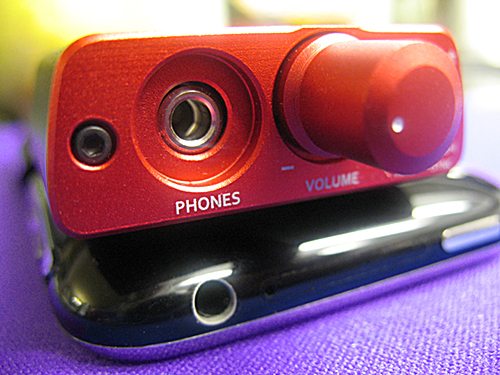
Lets get to it, then. How much better will my music sound using the Go-Dap vs. not using it? Well, that mostly depends not on what type music you like or even how loud you like your volume. What I discovered is that the advantages of the Go-Dap (and there are many) are much more dramatic with headphones than earphones. I don’t know if thats an ohms rating thing or not since headphones and earphones ratings are all over the map. Besides, I said I wouldn’t get into the numbers.
I began listening with a pair of JHAudio JH13/PRO custom earphones. These babies rival just about any pair of headphone in both sound and price. And I usually use them with my iPod with no external amp. So I was curious how different the Go-Dap would make it sound. I was both pleased and disappointed. Pleased because the sound was a bit fuller and more refined, like a harsh-like ”haze” had been removed. It was especially noticeable on AC/DCs “Back In Black.” The Go-Dap just took away a brightness that was not pleasant and made the song warmer in the process. But I was also disappointed because overall, these were subtle differences. There was no OMG moment. That held true after listening to different genres of music at different bit rates.
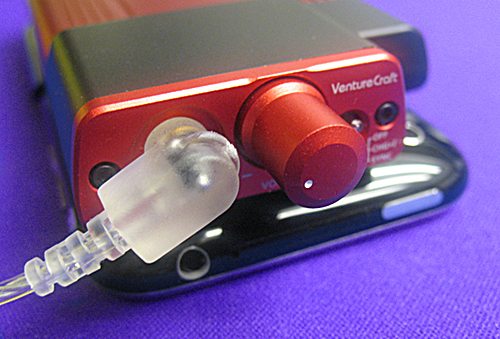
I then tried it with the EarJax Lyric earphones, a mid-priced model I will review separately soon. Pretty much the same story, although the volume difference seemed to be greater. But any musical improvements were even less noticeable that with the JH13/Pros. So I would have to say this test was a wash.
I then plugged in my Grado 325is headphones. And oh, boy, with Grado’s attention to detail backed by the power of the Go-Dap, “Who’s Next” kicked me in the head like never before. All of a sudden, I was taken back to my youth when I used to blast my eardrums using some godawful headphones I had at the time, but was too ignorant to appreciate good audio. But that specific memory of losing myself in the music it’s what’s carried forward, not the teenage distortion. The Cars “Moving In Stereo” from their eponymously titled album takes on a bit of a sinister attitude that is more subdued otherwise. But there’s a big problem here: The Go-Dap is for portable use and the Grado’s just aren’t. As much as I loved the improvement, it wasn’t a convenient combination.

I decided to pair the Go-Dap with the Bowers and Wilkins P5 headphones. While not the most portable headphones on the planet, the P5s were designed for home and commuting. Again, the difference was more dramatic on these than earphones. I noticed less background hiss in quiet spots using the Go-Dap. The hiss was still there, but not enough to really matter. Also there was more punch to the bass, which is interesting, because the P5s do that very well on their own. The Go-Dap/P5 combo really shines in intimate recordings like Diana Krall’s “East of the Sun (West of the Moon)”. This live track just shimmers and Krall’s vocals are seductively inviting. I will say that this song fares better on the P5 headphones when plugged into B&Ws own MM-1 speakers which have their own, proprietary digital audio processor, but the far less expensive Go-Dap comes close and you can take it with you!
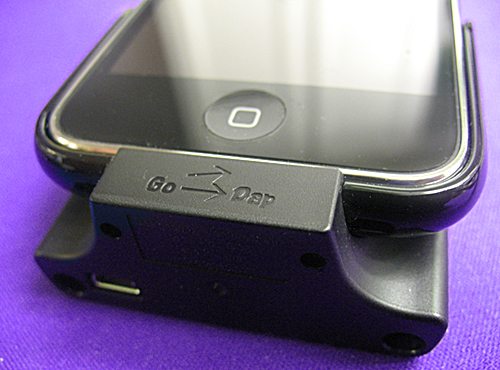
Overall, songs straight from the iPhone 3G/GS sound a bit anemic compared to Go-Dap. There are two reasons for this: First is obviously the amp. But the other, important reason is that when connected, the sound signal is being fed directly into the amp by way of the USB dock. The mini audio port of the iPhone is bypassed completely. The advantage of this is that the USB signal is cleaner due to the direct path. If the Go-Dap was connected through the audio port of the iphone, the signal would go through hoops to get to your ears. I know this description may not be the clearest, but the bottom line is that by going from USB to the amp, the sound signal degrades far less. And if you just spent $200 on an amp and charger, then you probably want the cleanest signal possible, which is what the USB port gives you. Note: If you have an iPhone 4, it will get even better, because the USB signal will remain totally digital until it reaches your earphones/headphones. VentureCraft will announce the details at CES 2011 in January.

All in all, VentureCraft’s Go-Dap is a useful and clever accessory to the iPhone 3G/GS. It improves the sound (substantially with headphones) and will give you decent backup battery power as an added bonus. Maybe you really can have your cake and eat it too.
While the Go-Dap only fits the iPhone 3G/GS for now and as I mentioned earlier, VentureCraft is working on an iPhone4 version which should be available early 2011.
I said I wouldn’t get into the numbers, but for reference’s sake, here are specs supplied by VentureCraft:
Output Power: 300mW
Signal-to-Noise Ratio: 95dB
Frequency Response 10Hz – 120KHz
Impedance: 16Ω – 300Ω
Output Terminal: Headphone Output (3,5mm)
Battery Type: Rechargeable Lithium-Ion Battery
Capacity: 1450mAH
Currently, there is no US distributer for the Go-Dap, but it can be purchased here: http://venturecraft.jp/gadget_en/product.php.
Apple iPhone 12, 64GB, Black - Fully Unlocked (Renewed)
16% OffApple iPhone 13, 128GB, Midnight - Unlocked (Renewed)
7% OffProduct Information
| Price: | $199 US |
| Manufacturer: | VentureCraft |
| Retailer: | VentureCraft |
| Requirements: |
|
| Pros: |
|
| Cons: |
|



Gadgeteer Comment Policy - Please read before commenting
Good review, but are they louder? I am hearing impaired. Will this help me ?
Marc,
I doubt this would help that much. But I am not qualified to know what would or wouldn’t help.
Take care
Bill H.